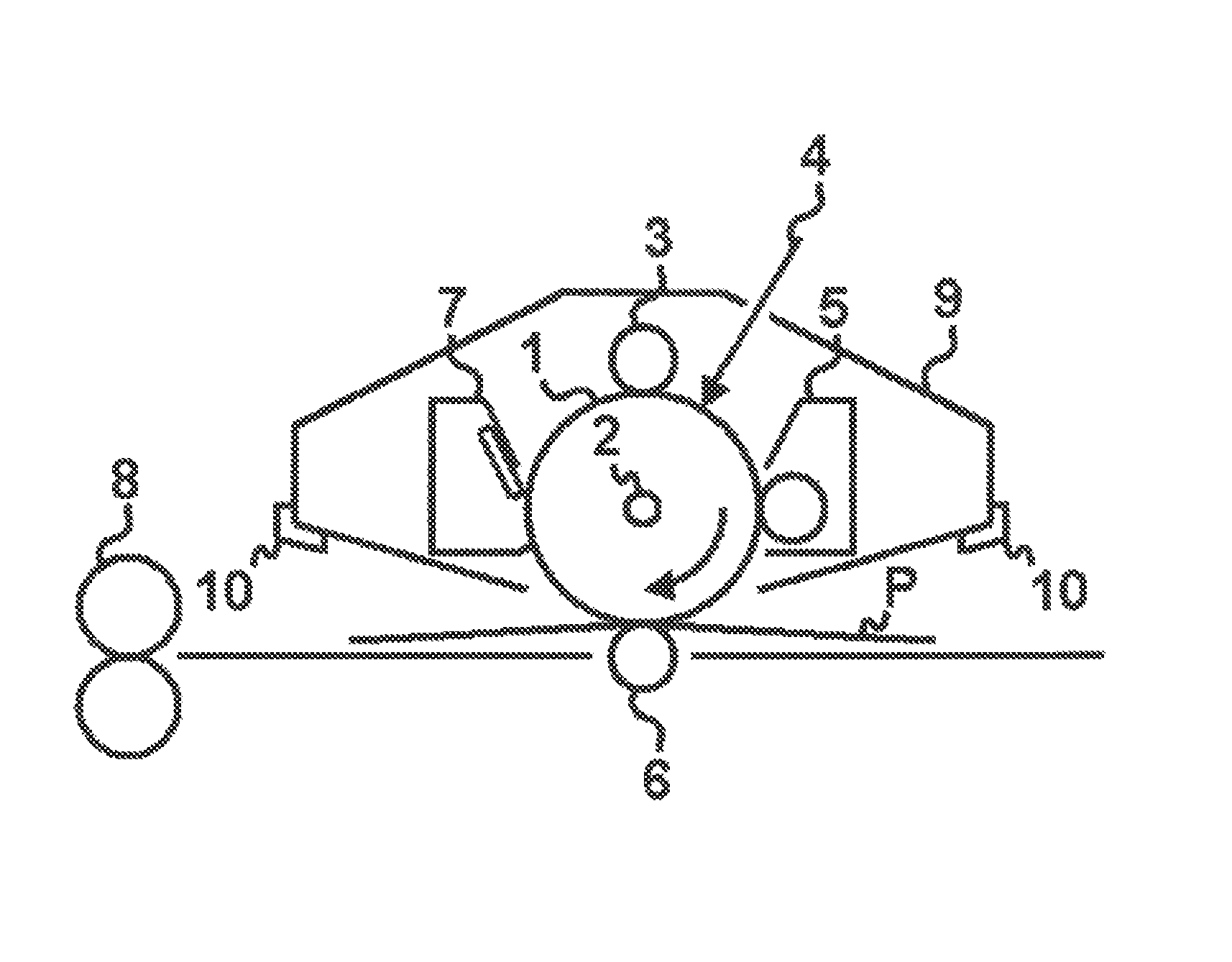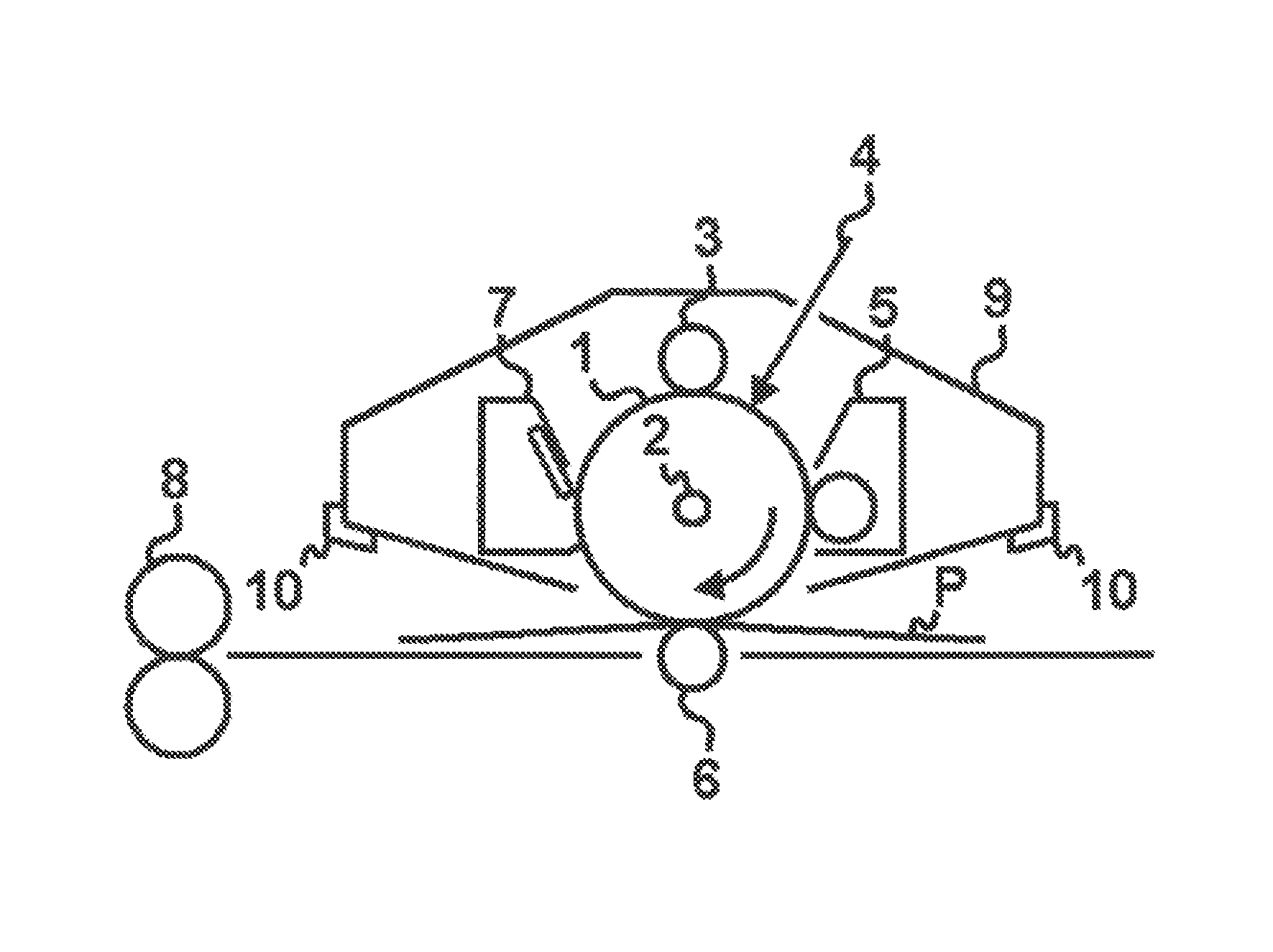Electrophotographic photosensitive member, process cartridge, electrophotographic apparatus and method of manufacturing the electrophotographic photosensitive member
a photosensitive member and electrophotography technology, applied in the field of electrophotographic apparatus and method of manufacturing the electrophotographic photosensitive member, can solve the problems of insufficient stress-reducing effect of electrophotographic photosensitive member, insufficient electrophotographic photosensitive member according to ptl 3, and inability to form an efficient matrix-domain structure in a surface layer. achieve the effect of potent stability
- Summary
- Abstract
- Description
- Claims
- Application Information
AI Technical Summary
Benefits of technology
Problems solved by technology
Method used
Image
Examples
example 1
[0134]An aluminum cylinder having a diameter of 30 mm and a length of 260.5 mm was used as a support. Next, a conductive-layer coating liquid was prepared by using a solvent mixture of SnO2-coated barium sulfate (conductive particle) (10 parts), titanium oxide (resistance-controlling pigment) (2 parts), a phenol resin (6 parts) and silicone oil (leveling agent) (0.001 part) with a solvent mixture of methanol (4 parts) and methoxypropanol (16 parts). The aluminum cylinder was dip-coated with the conductive-layer coating liquid, hardened at 140° C. for 30 minutes (thermal hardening) to form a conductive layer having a film thickness of 15 μm.
[0135]Next, N-methoxymethylated nylon (3 parts) and copolymerized nylon (3 parts) were dissolved in a solvent mixture of methanol (65 parts) and n-butanol (30 parts) to prepare an intermediate-layer coating liquid. The conductive layer was dip-coated with the intermediate-layer coating liquid, and dried at 100° C. for 10 minutes to obtain an inter...
examples 2 to 100
[0152]Electrophotographic photosensitive members each were manufactured in the same manner as in Example 1 except that the constituent α, the constituent β and the charge-transporting substance of charge-transporting layer in Example 1 were changed as shown in Tables 5 and 6 and evaluated in the same manner as in Example 1. It was confirmed, in the formed charge-transporting layer, that the matrix, which contains the constituent β and the charge-transporting substance, contains domains containing the constituent α. The results are shown in Table 10.
examples 101 to 150
[0153]Electrophotographic photosensitive members each were manufactured in the same manner as in Example 1 except that the constituent α, the constituent β and the charge-transporting substance of the charge-transporting layer in Example 1 were changed as shown in Table 7 and evaluated in the same manner as in Example 1. It was confirmed, in the formed charge-transporting layer, that the matrix, which contains the constituent β and the charge-transporting substance, contains domains containing the constituent α. The results are shown in Table 11.
[0154]Note that the weight average molecular weights of polycarbonate resins D used as the constituent β were:
(D) / (2-3)=5 / 5: 60,000
(D) / (2-4)=6 / 4: 65,000.
[0155]Note that in Examples 123 to 150, the copolymerization ratio of the repeating structural unit present in the resin forming the constituent β.
PUM
| Property | Measurement | Unit |
|---|---|---|
| number average particle size | aaaaa | aaaaa |
| number average particle size | aaaaa | aaaaa |
| thickness | aaaaa | aaaaa |
Abstract
Description
Claims
Application Information
 Login to View More
Login to View More - R&D
- Intellectual Property
- Life Sciences
- Materials
- Tech Scout
- Unparalleled Data Quality
- Higher Quality Content
- 60% Fewer Hallucinations
Browse by: Latest US Patents, China's latest patents, Technical Efficacy Thesaurus, Application Domain, Technology Topic, Popular Technical Reports.
© 2025 PatSnap. All rights reserved.Legal|Privacy policy|Modern Slavery Act Transparency Statement|Sitemap|About US| Contact US: help@patsnap.com



